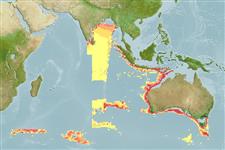Classification / Names
आम नाम | उपशब्द | Catalog of Fishes(वर्ग, प्रजाति) | ITIS | CoL | WoRMS | Cloffa
इलाज़मौबरांकी (शारक और रेज़) (sharks and rays) >
Squaliformes (Sleeper and dogfish sharks) >
Squalidae (Dogfish sharks)
Etymology: Squalus: Genus name from Latin 'squalus' meaning shark (Ref. 6885, 27436); nasutus: Name from Latin 'nasutus' meaning large-nosed, referring to its elongated prenarial snout..
More on authors: Last, Marshall & White.
Environment: milieu / climate zone / depth range / distribution range
पारिस्थितिकी
समुद्री; गहराई सीमा 300 - 850 m (Ref. 58443), usually 300 - 400 m (Ref. 58443). Tropical
Eastern Indian Ocean: Western Australia. Probably extending to Westerm Pacific, the Philippines and Indonesia.
Length at first maturity / आकार / वज़न / Age
Maturity: Lm ?, range 46 - ? cm
Max length : 49.9 cm TL पुल्लिंग / अलिंग; (Ref. 58443); 59.0 cm TL (female)
Short description
आकृति विज्ञान | मौरफोमैटरिक्स
This small species of the ‘japonicus group’ has the following set of characters: very elongate body, depth 9.4-11.4% TL; narrow and long snout, preoral length 1.85-2.01 times its horizontal prenarial length, 11.1-11.7% TL; large eyes, 4.3-5.1% TL; secondary lobe of anterior nasal flap is well developed; small, raked dorsal fins; first dorsal-fin spine short, weak; second dorsal-fin spine short with strong base; pectoral fin of adult not falcate; pectoral-fin inner margin is short, 6.6-7.1% TL; caudal bar almost upright, short, broad, extending from the caudal fork to the posterior margin of the upper lobe for 0.4-0.5 of its length, upper caudal blotch is somewhat linear, and is located near the dorsal margin of fin lobe; flank denticles weakly tricuspidate; monospondylous centra 36-39, precaudal centra 78-81, total centra 103-109 (Ref. 58443).
Occurs on or near the bottom of the upper continental slope at 298-850 m; viviparous with yolk-sac dependency; no reproductive and diet data are available, however, it is presumed that the species feeds on small fishes, cephalopods, and crustaceans (Ref. 58048). Trawled mainly in 300-400 m (Ref. 58443). Marketed for its meat, fins, and liver oil which is of high value (Ref. 58048).
Life cycle and mating behavior
परिपक्व अवधि | पुनरुत्पत्ति | मछलीऔ का अंडे देना | अंडे | Fecundity | लार्वा
Distinct pairing with embrace (Ref. 205).
Last, P.R., L.J. Marshall and W.T. White, 2007. Squalus nasutus sp. Nov., a new long-snout spurdog of the 'japonicus-group' from the Inidan Ocean. pp. 83-90. In P.R. Last, W.T. White and J.J. Pogonoski Descriptions of new dogfishes of the genus Squalus (Squaloidea:Squalidae). CSIRO Marine and Atmospheric Research Paper No. 014. 130 pp. (Ref. 58443)
IUCN Red List Status (Ref. 130435)
Threat to humans
Harmless
Human uses
अधिक जानकारी
Age/Sizeबाढ़Length-weightLength-lengthLength-frequenciesमौरफोमैटरिक्सआकृति विज्ञानलार्वालारवल गतिकीभर्तीबहुतायतBRUVS
संदर्भजलीयकृषिजलीयकृषि रूपरेखाखींचआनुवंशिकीElectrophoresesहैरेटिबिलटीबीमारीप्रक्रमणNutrientsMass conversion
सहयोगीयोतस्वीरेStamps, Coins Misc.ध्वनिसिगुयटिरारफ्तारतैरने के प्रकारगिल क्षेत्रOtolithsदिमागदृष्टि
साधन
Special reports
Download XML
इंटरनेट स्रोत
Estimates based on models
Preferred temperature (Ref.
123201): 8.9 - 13.1, mean 10.8 °C (based on 56 cells).
Phylogenetic diversity index (Ref.
82804): PD
50 = 0.5000 [Uniqueness, from 0.5 = low to 2.0 = high].
Bayesian length-weight: a=0.00339 (0.00162 - 0.00707), b=3.10 (2.93 - 3.27), in cm total length, based on LWR estimates for this Genus-body shape (Ref.
93245).
Trophic level (Ref.
69278): 4.2 ±0.3 se; based on size and trophs of closest relatives
लौटाव (Ref.
120179): निम्न, न्यूनतम जनसंख्या दुगनी होने का समय 4.5 - 14 वर्ष। (Preliminary K or Fecundity.).
Fishing Vulnerability (Ref.
59153): Moderate vulnerability (44 of 100).
